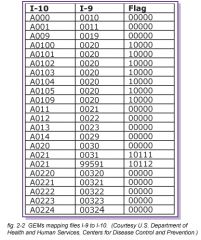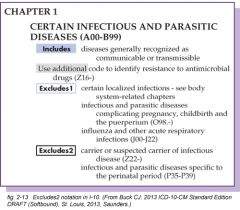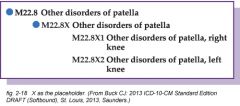![]()
![]()
![]()
Use LEFT and RIGHT arrow keys to navigate between flashcards;
Use UP and DOWN arrow keys to flip the card;
H to show hint;
A reads text to speech;
23 Cards in this Set
- Front
- Back
|
ICD-10-CM
|
* International Classification of Diseases-10th Revision-Clinical Modification was issued in 1993 by the World Health Organization (WHO)
* the classification system that will be used to identify illness (morbidity) and death (mortality) when it replaces ICD-9-CM on October 1, 2014 * The common coding system allows for continuity of data. The ICD-10-CM is based on the worldwide version—ICD-10. As you know, "CM" stands for Clinical Modification. * The World Health Organization's official version of the 10th revision of the International Classification of Diseases includes clinical modifications (CM) that provide more detail for diagnostic indexing for morbidity data. * In the United States the National Center for Health Statistics (NCHCS) is responsible for the disease classification system (Volumes 1 and 2), known as ICD-10-CM, which differs from the ICD-10 only in the code subsets. * All data gathered with the ICD-10-CM coding system collapse back into the ICD-10 codes to provide global uniformity of data * All I-10 codes start with a letter and can have as many as 7 characters * I-10 codes are alphanumeric * The Centers for Medicare and Medicaid Services is responsible for developing the procedure classification entitled the ICD-10-PCS (Procedure Coding System), which will replace ICD-9-CM, Volume 3 * The NCHS released the International Classification of Disease, 10th revision, Clinical Modification (ICD-10-CM) in July 2007, replacing the "pre-release draft of June 2003." This was followed by updated versions in 2009, 2010, 2012, and 2013. None of these releases were intended for public viewing and the codes were not valid for any purpose. * Full implementation of ICD-10-CM is expected on October 1, 2014 * I-10 will replace I-9, volumes 1 and 2 * There are 21 chapters in the new ICD-10-CM and all have similar titles as the ICD-9-CM. There are two new chapters: "Eye and Adnexa" and "Ear and Mastoid Process." * Chapter 20 describes "External Causes of Morbidity," and Chapter 21 "Factors Influencing Health Status and Contact with Health Service." * There are no V or E codes as you know them from ICD-9-CM classification * Each section in the I-10 begins with a unique letter, and codes are arranged in numeric order * Laterality is a component of code selection in I-10 * Publishers may enhance their I-10s with notations and symbols that are not part of the official version of the coding system |
|
|
NCHS
|
* The Technical Advisory Panel was established by NCHS to provide input during the development of the 10th revision of I-10
* is responsible for developing the disease classification system, entitled I-10 |
|
|
Improvements in the ICD-10-CM
|
1. Addition of information relevant to ambulatory and managed care encounters
2. Expansion of injury codes 3. Extensive expansion of the injury codes allows for greater specificity. 4 Creation of combination diagnosis/symptom codes to reduce the number of codes needed to fully describe a condition (NOT expansion of signs and symptoms codes.) 5. The addition of a sixth character 6. The incorporation of common fourth- and fifth-digit subclassifications 7. Updating and greater specificity of diabetes mellitus codes 8. Facilitation of providing greater specificity when assigning codes * Using the same format as the I-9, the I-10 index is alphabetic, presenting the main terms in bold type and subterms indented under the main term (Figure 2-9 in your text). * After the index entry, a code is provided. Sometimes, only the first four characters of the code are given. To ensure that you have chosen the correct code and/or to obtain the remaining characters, you must always reference the Tabular |
|
|
ICD-10-CM chapters
|
Chapter 1 Certain Infectious and Parasitic Diseases (A00–B99)
Chapter 2 Neoplasms (C00–D49) Chapter 3 Disease of the Blood and Blood-Forming Organs and Certain Disorders Involving the Immune Mechanism (D50–D89) Chapter 4 Endocrine, Nutritional, and Metabolic Diseases (E00–E89) Chapter 5 Mental, Behavioral and Neurodevelopmental Disorders (F01–F99) Chapter 6 Diseases of Nervous System (G00–G99) Chapter 7 Diseases of Eye and Adnexa (H00–H59) Chapter 8 Diseases of Ear and Mastoid Process (H60–H95) Chapter 9 Diseases of Circulatory System (I00–I99) Chapter 10 Diseases of Respiratory System (J00–J99) Chapter 11 Diseases of the Digestive System (K00–K95) Chapter 12 Diseases of Skin and Subcutaneous Tissue (L00–L99) Chapter 13 Diseases of the Musculoskeletal System and Connective Tissue (M00–M99) Chapter 14 Diseases of Genitourinary System (N00–N99) Chapter 15 Pregnancy, Childbirth, and the Puerperium (O00–O9A) Chapter 16 Certain Conditions Originating in the Perinatal Period (P00–P96) Chapter 17 Congenital Malformations, Deformations, and Chromosomal Abnormalities (Q00–Q99) Chapter 18 Symptoms, Signs, and Abnormal Clinical and Laboratory Findings, Not Elsewhere Classified (R00–R99) Chapter 19 Injury, Poisoning, and Certain Other Consequences of External Causes (S00–T88) Chapter 20 External Causes of Morbidity (V01–Y99) Chapter 21 Factors Influencing Health Status and Contact with Health Services (Z00–Z99) |
|
|
General Equivalence Mappings (GEMs)
|
* To help with the conversion from I-9 to I-10, General Equivalence Mappings (GEMs) have been developed to act as crosswalks for these systems.
1. I-9 to I-10, which is forward mapping (Fig. 2-1) 2. I-10 to I-9, which is backward mapping (Fig. 2-2) Note that the GEMs files do not contain decimal points. ** In the GEMs file for I-9, code 001.0 is 0010 and code 001.1 is 0011 ** In the GEMs file for I-10 codes, A00.0 is A000 and A00.1 is A001 * Both GEMs files include a column for flags that identify how closely the code sets correlate |
|
|
forward mapping
|

.
|
|
|
backward mapping
|

|
|
|
flag designations
|
three different types:
1. Approximate 2. No Map 3. Combination 4. Scenario 5. Choice List The fourth field is the Scenario field and fifth field is the Choice List. These two numbers appear after the three flags and indicate a further subdivision of the flags (Fig. 2-7) * flag number refers to the placement of the digit. ie. Flag 3 - the third digit in the flag * when 00000 is displayed in the flag field, there is only a single entry available |
|
|
Approximate flag designations
|
* Approximate, Flag 0. The Approximate, Flag 0, means there is a direct match between the two coding systems, and the GEMs file directs the coder to a single entry.
* Approximate, Flag 1. The Approximate Flag 1 identifies those times when more than one code in the I-10 is available to replace an I-9 code. * 10000 flag indicates that although there is a one-to-one code mapping, the codes may not be exactly the same because the choice of code depends on the trimester. |
|
|
No Map flag designations
|
* No Map means that there is no similar code from one coding system to the other. When this occurs, there will be a 1 as the second digit in Flag 2.
* For example, the I-10 code, T36.6X6A, Poisoning by, adverse effect of and underdosing of rifampicins, initial encounter, has no match in I-9. In the I-9 column, "NoDx" appears and there is a 1 in the Flag 2 position. |
|
|
Combination flag designations
|
* Combination, Flag 3 (third digit in the flag), contains a 1 when a code from the source system must be linked to more than one code in the target system to be valid. * For example, in the I-10 system, R65.21, Severe sepsis with septic shock, would require two I-9 codes (995.92, * Severe sepsis, and 785.52, Septic shock) to fully report. The I-10 GEMs file displays this requirement with a 1 in the third field.
|
|
|
Scenario flag designations
|
* 4th field - flag 4
* is the number of variations of diagnosis combinations included in the source system code. * 1 in the scenario field (4th field) indicates there is only ONE combination |
|
|
Choice List flag designations
|
* 5th field - flag 5
* indicates the possible target system codes that when combined are one valid scenario * 1 in the Choice List field (5th field) indicates the first code i the combination * 2 in the Choice List field indicates the second code in the combination |
|
|
Tabular
|
.
|
|
|
Includes
|

The word "Includes" appears under certain categories to further define or give examples of the content of the category
|
|
|
Excludes
|

* The I-10 has two types of Excludes notes. Each note has a different meaning.
1. Excludes1. An Excludes1 note is a pure excludes. It means "NOT CODED HERE!" and indicates that the code excluded should not be assigned at the same time as the code above the Excludes1 note. * ie. Chronic tonsillitis (J35.01) with hypertrophy of the adenoids (J35.2) is an Excludes1 2. Excludes2. An Excludes2 note represents "Not included here." An Excludes2 note indicates that the condition excluded is not part of the condition it is excluded from but a patient may have both conditions at the same time. When an Excludes2 note appears under a code, it is acceptable to use both the code and the Excludes2 code together. |
|
|
Code First/Use Additional Code
|

* Certain conditions have both an underlying etiology and multiple body system manifestations.
* The I-10 has a coding convention that requires the underlying condition be sequenced first followed by the manifestation. * Wherever such a combination exists there is a "Use additional code" note at the etiology code, and a "Code first" note at the manifestation code. * ie. Neutropenia with associated fever is an example of Use additional code * I-10 has a coding convention that requires the underlying condiition br sequenced first followed by the manifestation * code titled "in deseases classified elsewhere" indicates that the code is a manifestation code * "in diseases classified elsewhere" codes are never first-listed codes. |
|
|
Code Also
|
* A "Code also" note instructs that two codes may be required to fully describe a condition.
* Sequencing of the two codes is dependent on the severity of the conditions and the reason for the encounter. |
|
|
7th Characters and Placeholder X
|

* For codes less than 6 characters that require a 7th character, a placeholder X should be assigned for all characters less than 6
A = initial encounter D = subsequent encounter S = sequela |
|
|
instructional notations
|
The I-10 has instructional notations to provide guidance to the coder
* Includes * Excludes * Code First/Use Additional Code * Code Also * 7th Characters and Placeholder X |
|
|
I-10
|
* I-10 is already widely used in Australia (being used there all the time) also book states widely used in Europe
* has 5 times more codes than I-9, 69K vs. 14K * pregnancy complication codes are now based on the trimester, whereas I-9 is based on episode of care |
|
|
procedures coding system (PCS)
|
* used in the United States fro the I-10 system that reports inpatient procedures
|
|
|
ICD-10-PCS
|
• International Classification of Diseases, Tenth Revision, Procedure Coding System
• Replaces Volume 3 of ICD-9-CM • Used to report inpatient hospital procedures • 7 alphanumeric characters • Each character has as many as 34 different values o Character 1: Identifies the section o Character 2: Body System o Character 3: Root Operation (Exception: Radiation, Oncology, Rehab, Mental Health) o Character 4: Body Part o Characters 5, 6, and 7: Identify approach, contrast, devices, special qualifiers and vary between chapters |

